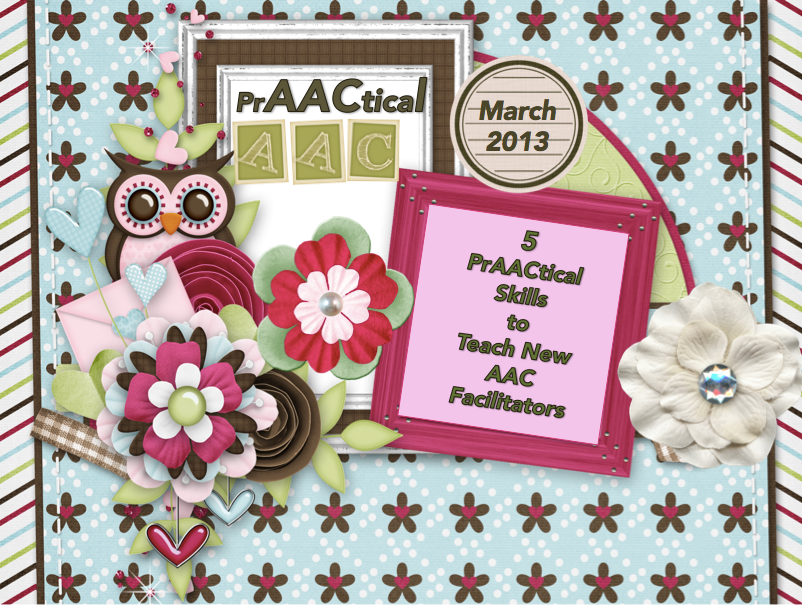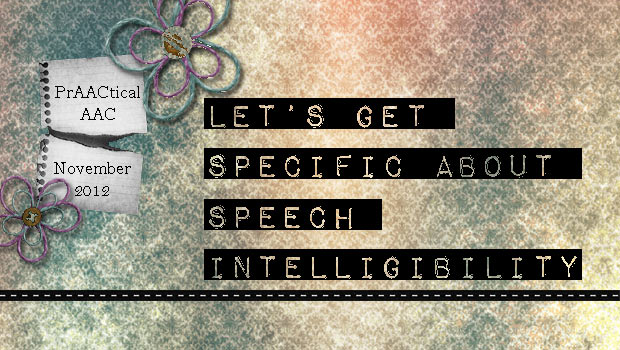March 8, 2013
by Robin Parker -

We have been out and about in our community these past couple of weeks. We have worked with speech-language pathologists, teachers, resource specialists, paraprofessionals, and families. We love doing AAC facilitator training because the impact is so important for not only our current AAC learners but for future AAC learners as well. There are really great professionals who want to provide the best AAC support possible. They want and need AAC information that will help them integrate AAC facilitation strategies into their already very busy days. Here are 5 AAC facilitation strategies that have made the most impact: Using Aided Language Input (ALI)– Talk AAC to the learner. This strategy is not only a very powerful teaching tool, but when discussed with new AAC facilitators, seems to make perfect sense (many have never heard of it). One key for learning ALI is to practice it in a variety of activities... [Read More...]
December 7, 2012
by Carole Zangari -

Last month, we talked a lot about semantic intervention with people who are learning AAC. Once we got started, we realized we could have done another whole month on the topic, but we had to move on. We ran out of time before we could really talk about outcome measures. As clinicians, how do we determine whether our therapy is effective? Here are some things to do after you’ve provided high-quality, well-sequenced vocabulary instruction. Make small comprehension checks a regular part of your instruction. Ask the AAC learner to tell you about ___ . Then score their response as objectively as possible (e.g., complete & correct, correct but incomplete, vague, incorrect). You’ll get some real-time feedback and can clarify or re-teach as necessary. Assess in a standardized fashion. Standardized means doing something the same way each time. Set up appropriate assessment tasks that allow you to judge how well the... [Read More...]
November 23, 2012
by Carole Zangari -

When we’re writing AAC evaluation reports, compiling funding documents, and summarizing the present level of performance in IEPs, we frequently comment on speech intelligibility. In some cases, we’ve administered a standardized assessment instrument and are sharing those results. Often, though, the comments are more descriptive in nature. It is not uncommon to read documentation in which someone with articulation difficulties is described as having speech intelligibility that is mildly, moderately, or severely impaired. Those categories are pretty broad, open to interpretation, and can be quite vague. What do we really mean when saying that someone does or doesn’t have intelligible speech? To narrow down the meaning, we specify the two variables that have the greatest influence on how comprehensible the communicator’s speech output actually is: the context and the communication partner. Specifying whether the context is known and the partner is a familiar one, helps us better interpret the descriptors... [Read More...]
November 15, 2012
by Robin Parker -

Part of TEACHING vocabulary to AAC users (or any learner) involves reinforcement. Reinforcement is more than just facilitating positive self esteem. It is also about providing feedback that will help increase the skill you are trying to teach. It’s even more than learning specific new words but also about strategies to attack learning new words outside of the therapy or classroom environment. Below are some examples of ways to make the most of your reinforcement and some ways to NOT. 🙂 SAY THIS… General Principles of Reinforcement for Vocabulary: Be specific to the goal. Use words that explain the skill you want to occur more often. Use excited positive vocal inflection, Be impressed! We are continuing with the example of teaching the word consumed from Carole’s post on Monday, What Makes A Good Vocabulary Teaching Activity. ‘Wow you discovered a NEW WAY of saying take in, you used consumed’! ‘Awesome... [Read More...]



